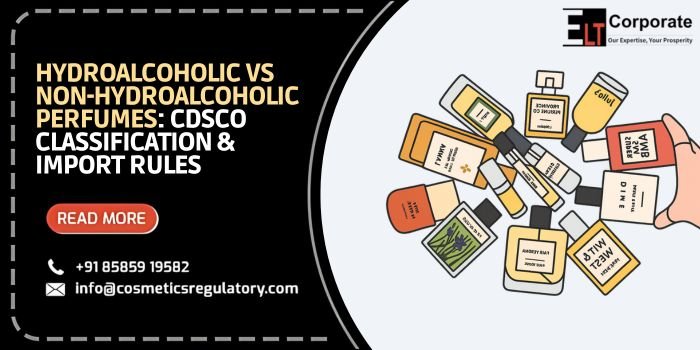Perfume is one of the most popular cosmetic imports in India. However, before you start importing, it is important to know how the Central Drugs Standard Control Organization (CDSCO) classifies the perfume. The main difference is located between hydrochloric perfumes (alcohol-based) and non-hydrocolic perfumes (oil- or water-based).
This classification directly affects whether your product requires CDSCO cosmetic import registration, which documents you need, and how to withdraw customs duty. This article explains the difference between hydrochloric and non-hydrocolic perfumes, their CDSCO classification and step-by-step process to import them to India.
Table of Contents
ToggleWhat are Hydroalcoholic Perfumes?
Hydrocolic perfumes are fragrances that contain a high percentage of ethyl alcohol along with aromatic oils. Common examples include:- Eau de Cologne
- Eau de Toilette
- Eau de Parfum
What are Non-Hydroalcoholic Perfumes?
Non-hydroalcoholic perfumes are alcohol-free alternatives, typically made using:- Natural oil blends (Attars/Ittars)
- Water-based sprays
- Cream or gel-based perfumes
CDSCO Classification of Perfumes
- Hydrocolic perfume: Compulsory CDSCO cosmetic import registration (Form 42 and Form 43) is required.
- Non-hydrocolic perfume: CDSCO registration can be exempted, but compliance with safety and labelling requirements is mandatory.
Who Can Import Perfumes into India?
Perfumes can be imported by:- Individuals/Travellers – under personal effects within the duty-free limit (₹50,000).
- Businesses/Retailers – importing bulk quantities for resale.
- Online Shoppers – buying perfumes from foreign e-commerce stores (duties apply).
Step-by-Step Process to Import Perfumes into India
Step 1: Classify the Product
Confirm whether your perfume is hydroalcoholic or non-hydroalcoholic. This will determine if CDSCO registration is required.Step 2: Register Business & Obtain IEC
Every commercial importer must obtain an Import Export Code (IEC) from DGFT.Step 3: Appoint Authorised Agent (if applicable)
If the foreign manufacturer applies for registration, they must appoint an Authorised Indian Agent (AIA). If the Indian importer applies directly, this step is not required.Step 4: Apply for CDSCO Cosmetic Import Registration
For hydroalcoholic perfumes:- Submit Form 42 with supporting documents (labels, composition details, Free Sale Certificate, safety data, etc.).
- CDSCO issues Form 43 after approval.
- Registration is valid for 3 years and must be renewed before expiry.
Step 5: Ensure Labelling Compliance
Every perfume must display:- Product name & net quantity
- Batch number & expiry date
- Importer’s details, MRP, and country of origin
- Import license number (mandatory under Cosmetic Rules, 2020)
Step 6: Ship & Clear Customs
Ship through approved ports. Submit:- IEC
- Form 43 (for hydroalcoholic perfumes)
- Invoice & packing list
- Bill of Lading/Airway Bill
Step 7: Sell & Maintain Ongoing Compliance
- Maintain import & sale records
- Renew CDSCO registration every 3 years
- Ensure all safety standards are followed
Documentation Required for Import
- Import Export Code (IEC) – DGFT
- CDSCO Import Registration (Form 43, if hydroalcoholic)
- Form 42 application with documents
- Power of Attorney (if AIA involved)
- Free Sale Certificate from the country of origin
- Certificate of Origin
- Commercial Invoice & Packing List
- Bill of Lading/Airway Bill
- Stability and safety test reports (if demanded by CDSCO)
- Product Ingredient List & Safety Data
- Sample Labels as per Indian requirements
Benefits of Complying with CDSCO Rules
- Smooth Customs Clearance – Avoid delays and penalties
- Market Access – Sell through retail, distribution & e-commerce legally
- Consumer Trust – Prove authenticity & safety
- Better Profits – Import duty-free stock for resale
- Regulatory Protection – Avoid confiscation and litigation
How ELT Corporate Can Help?
At ELT Corporate, we make perfume imports seamless and 100% compliant. We assist with:- CDSCO Cosmetic Import Registration (Forms 42 & 43)
- IEC code registration
- Labelling & Legal Metrology compliance
- Customs paperwork & clearance
- Renewal & ongoing regulatory support



